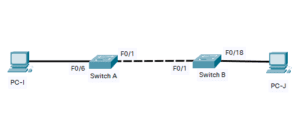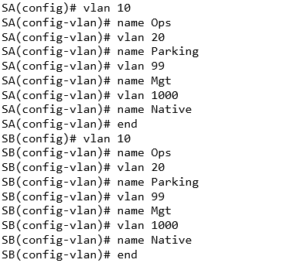How to Properly Configure a VLAN
The general migration from hubs to switches has enabled network administrators to mitigate the collisions between sender and receiver computers on a network by creating collision domains. A collision occurs when two computers compete for the same network resource, creating a scheduling dilemma as to which computer will access the resource first, which causes delays on the network.
Do you need urgent assignment help ? Reach out to us. We endeavor to assist you the best way possible.
Switched networks isolate these collisions into domains so that devices that are administrated over by one switch cannot have collisions with devices under a different switch. However, the ability to have a wide, flat level 2 switched domain still creates a collision problem within the same switched network (Chukwuemeka, 2015). This means that there are many devices connected to a local area network via one switch, with a potential for massive delays as a result of collisions within the domain, hence the need to resolve this dilemma. Virtual local area networks (VLAN) break down a physical LAN into more manageable units by logically grouping several host computers irrespective of their physical location (Cisco.com), meaning one can set up a VLAN across different physical LANs.
Owing to the ability of one physical host to support multiple VLANs, there needs to be a way for the VLAN hosts to communicate effectively while avoiding collisions and protecting the privacy of packets being transmitted on the VLANs. Trunking is a way of creating a point-to-point link between two hosts that contain multiple VLANs, where a trunk link switches using an additional tag on the port information attached to a packet, allowing one to extend a VLAN over an entire network.
Configuring a VLAN with Trunking
A VLAN makes use of native ports to transmit frames and packets within itself as the host presumes to know the destination device implicitly when sending a frame. However, since a switch can have multiple VLANs, it requires knowing which way to route the packet, so one VLAN’s frames don’t end up in another VLAN. Consider a network with 2 hosts I, and J. I and J are connected by a VLAN over two switches, A and B.
Necessary Resources
- 2 Cisco switches with Cisco IOS Release 15.2(2) lanbasek9 ISO/similar
- 2 Windows PCs with virtualization software
- Console wires to set up the Cisco IOS nodes via the ports
- Ethernet cabling as required by the topology diagram
- In the absence of a physical network, Cisco Packet Tracer software will suffice
Procedure
Building a New Network
Using Cisco Packet Tracer to simulate a physical network:
- Cable the network as shown in the topology diagram
- Set up primary config for every switch
- Configure PC-I and J hosts using the addressing table in the appendix
- Test connectivity by pinging the hosts on the network
Creating the VLAN
- Create the desired VLANs on both switches
- Issue the “show vlan brief” command to generate a list of virtual LANs on switch A
- Designate virtual LANs to the appropriate switch ports
Maintain Virtual LAN Ports and Database
Using the steps from above,
- Designate a virtual LAN to multiple ports
- Delete a virtual LAN assignment from a port
- Clear a virtual LAN key from the virtual LAN database
Set Up a Trunk to Link the Two Switches
Employ DTP to start a trunk on F0/1
Set up a trunk interface on F0/1 – the command is used to explicitly set up an interface port as a trunk. Issue it on both ends of the link
Dispose of the Virtual LAN db
Check if the VLAN database exists
Remove VLAN database
References
Cisco.com (2021), Software Configuration Guide, Cisco IOS Release 15.2(5)EX (Catalyst Digital Building Series Switches), Information About VLAN Trunks. Material available online at: https://www.cisco.com/c/en/us/td/docs/switches/lan/catalyst_digital_building_series_switches/software/15-2_5_ex/configuration_guide/b_1525ex_consolidated_cdb_cg/b_1525ex_consolidated_cdb_cg_chapter_0110101.pdf
Chukwuemeka A, Nweso N, Ojiugwo C (2015), The Proposed Roles of VLAN and Inter-VLAN Routing in Effective Distribution of Network Services in Ebonyi State University, International Journal of Science and Research (IJSR) 4(7):2608-2615
Appendix:
ORDER A PLAGIARISM-FREE PAPER HERE
We’ll write everything from scratch
Question

Healthcare Management – Theory X and Theory Y
Prepare a leaflet to explain Theory X and Theory Y to your healthcare manager.
Explain how the healthcare manager’s perception affects the attitude and behavior of healthcare workers.
Describe the 4 stages of perception.
Include a recommendation on how the participation of healthcare workers in decision-making would lead to greater achievement for the healthcare manager, team members, and the organization.
Deliverable Requirements
Include at least 3 references.
Use the APA format
ORDER A PLAGIARISM-FREE PAPER HERE
We’ll write everything from scratch
Question

How to Properly Configure a VLAN
As a senior network administrator, you are tasked with training junior network admins on VLANs. Write a minimum 2-page APA formatted essay on how to configure VLAN, including trunking. Your essay should be written like a training guide, in which you train junior network administrators on how to properly configure VLAN, including trunking. Make sure you include commands needed and descriptions of how the commands help make the VLAN functional on an enterprise network. The format should include steps and screenshots so it is easy for someone else to follow.










